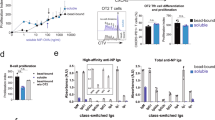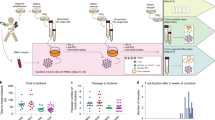Abstract
THYMUS-DERIVED lymphocytes (T cells), which participate in many regulatory and effector functions of the immune system, are divided into distinct subpopulations. Thus, T cells causing cell-mediated cytotoxicity can be distinguished from those cooperating with bone marrow-derived lymphocytes (B cells) in the humoral response1–3. Cytotoxic T cells also seem to be distinct from the cells responsible for the mixed lymphocyte and graft versus host reactions4,5. Furthermore, T-cell subpopulations can interact with each other to augment various cell-mediated immune responses6–8. We have investigated whether the T cells causing contact sensitivity belong to a different subset from those causing cell-mediated cytotoxicity. Our studies were based on two observations: first, that in mice contact sensitivity to the trinitrophenyl group (TNP) can be transferred adoptively by spleen or lymph node cells of sensitised animals; and, second, that cytotoxic T cells able to lyse TNP-coupled target cells can be induced in vitro11–13. We have found that contact sensitivity cells fail to display cytotoxicity, while cytotoxic cells fail to transfer contact sensitivity. From this we conclude that these two functions are performed by distinct T cell subpopulations.
This is a preview of subscription content, access via your institution
Access options
Subscribe to this journal
Receive 51 print issues and online access
$199.00 per year
only $3.90 per issue
Buy this article
- Purchase on Springer Link
- Instant access to full article PDF
Prices may be subject to local taxes which are calculated during checkout
Similar content being viewed by others
References
Dennert, G., and Lennox, E. S., J. Immun., 113, 1553 (1974).
Kisielow, P, et al., Nature, 253, 291 (1975).
Elliott, B. E., and Haskill, J. S., Nature, 252, 607 (1974).
Bach, F. H., et al., Science, 180, 403 (1973).
Howe, M., Beerman, L., and Cohen, C., J. Immun., 111, 1243 (1973).
Cantor, H., and Asofsky, R., J. exp. Med., 135, 764 (1972).
Wagner, H., J. exp. Med., 138, 1379 (1973).
Dennert, G., J. Immun., 114, 1570 (1975).
Asherson, G. L., Allwood, G. G., and Mayhew, B., Immunology, 25, 285 (1973).
Zembala, M., and Asherson, G. L., Nature, 244, 228 (1973).
Shearer, G. M., Eur. J. Immun., 4, 527 (1974).
Dennert, G., and Hatlen, L. E., J. Immun., 114 (1975).
Dennert, G., Nature, 255, 712 (1975).
Asherson, G. L., and Ptak, W., Immunology, 15, 405 (1968).
Röllinghoff, M., and Wagner, H., Eur. J. Immun., 3, 471 (1973).
Asherson, G. L., and Ferluga, J., Immunology, 25, 471 (1973).
Gell, P. G. H., and Benacerraf, B., J. exp. Med., 113, 571 (1961).
Benacerraf, B., and Gell, P. G. H., Immunology, 2, 219 (1959).
Author information
Authors and Affiliations
Rights and permissions
About this article
Cite this article
DENNERT, G., HATLEN, L. Are contact hypersensitivity cells cytotoxic?. Nature 257, 486–488 (1975). https://doi.org/10.1038/257486a0
Received:
Accepted:
Issue Date:
DOI: https://doi.org/10.1038/257486a0
This article is cited by
-
The langerhans cell: The master key to contact dermatitis: A hypothesis
Archives of Dermatological Research (1982)
-
Ultrastructural studies of allergic contact dermatitis in man
Archives of Dermatological Research (1980)
-
A new differentiation antigen defining a subpopulation of mouse T cells
Nature (1976)
Comments
By submitting a comment you agree to abide by our Terms and Community Guidelines. If you find something abusive or that does not comply with our terms or guidelines please flag it as inappropriate.



